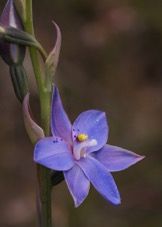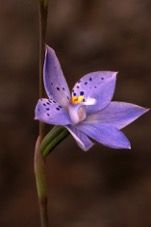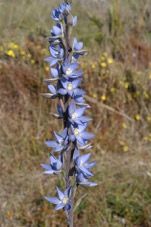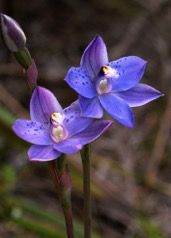Identifying some of the blue sun orchids that grow in the Anglesea district can often be a daunting challenge and one sometimes has to take an educated guess as to what species we are looking at.
They are usually all flowering in October and November.
For many years it was very easy to identify the blue Spotted Sun Orchid, Thelymitra ixioides, as it was the only spotted sun orchid in the district.

Spotted Sun Orchid
That was before the Large-spotted Sun Orchid (Rush-leaf Sun Orchid), Thelymitra juncifolia, arrived on the scene.

Large-spotted Sun Orchid
The situation is that there are indeed very few specimens of T. ixioides in our district. The blue spotted sun orchid that you find is most likely T. juncifolia.
How can you tell the difference?
The column is the distinguishing feature – the column of T. ixioides is somewhat taller and narrower than that of T. juncifolia and the yellow apex is highly ornamented with rows of dense finger-like glands, while that of T. juncifolia has far fewer of these decorative glands. T. ixioides is insect pollinated and the flowers open freely on warm days to attract pollinators. If the flower is finished and the ovaries are not swollen, the orchid you are looking at could easily be T. ixioides. On the other hand T. juncifolia is self-pollinated and you will often notice that the ovaries of all the flowers on the stem are swollen. T. ixioides is a stronger plant – it can grow up to 80 cm and the flowers can be 50 mm across. T. juncifolia grows to about 45 cm tall and the flowers are about 35 mm across. Confused? Just admire them!
There are other challenges with blue sun orchids – are you looking at Slender Sun Orchids, T. pauciflora or Trim Sun Orchids, T. peniculata? The leaf can be a distinguishing feature.

Slender Sun Orchid

Trim Sun Orchid
T. peniculata has a fleshy leaf more than 10 mm wide while T. pauciflora has a slender fleshy leaf to 6 mm wide. T. pauciflora bears up to five small, pale flowers while T. peniculata can bear up to 18 usually deep purple flowers. The column of course is also important to observe – the yellow apex at the top of the column in T. peniculata always has dark brown or black adjoining the yellow. The top of the column of T. pauciflora is either all yellow or has reddish brown adjoining the yellow. T. pauciflora covers its face with white hairs from the end of the column arms. The hairs on T. peniculata do not touch the front of the column.
Confused? Just admire them.
Luckily we have some blue sun orchids that do not challenge our ID skills. Who could be mistaken in identifying the Giant Sun Orchid, T. aristata, or the rare Merran’s Sun Orchid, T. merraniae, with the golden crown on top of its column?

Giant Sun Orchid

Merran’s Sun Orchid
Or indeed the Peppertop Sun Orchid, T. brevifolia, which has a short leaf with reddish margins and a bright orange-brown top of the column?

Peppertop Sun Orchid
All our sun orchids should be flowering in October and November. There are so many leaves appearing in early September and I am hoping that the flowers will be still there to welcome me when I return from holiday at the commencement of November. I will be looking forward to sharing your observations.
Remember that photos and descriptions of all our orchids are found in Orchids of the Anglesea District available from Angair.
Margaret MacDonald